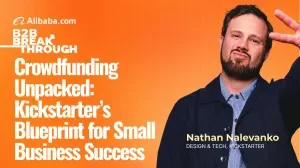When most entrepreneurs think about crowdfunding, they see dollar signs. A way to raise capital without giving up equity or taking on debt. But according to Nathan Nalevanko, Senior Design and Tech Outreach Lead at Kickstarter, that’s missing the bigger picture entirely.
“Kickstarter is a live test of product market fit,” Nalevanko explains. “It’s where rubber meets the road. It’s not just asking folks, would you want this thing if I gave it to you for X number of dollars. Through crowdfunding, you’re getting that live support and also the kind of live feedback from users.”
This shift in perspective changes everything about how successful creators approach their campaigns—and it explains why some side projects accidentally become million-dollar businesses while others with better funding strategies fail completely.
Table of Contents
1. The $1.2 Million Side Project
2. Why Backers Ask for Higher Prices
3. The Marketing Mistake That Kills Campaigns
The $1.2 Million Side Project
Christian Reed never intended to build a full-time company. His construction tool project was meant to be “a cool little side hustle to diversify with work.” But when he launched on Kickstarter in June 2020, market timing and genuine product-market fit collided perfectly.
“$1.2 million later closed out about 45 days,” Reed recalls. “And then the conversation becomes a lot different from side project to, Hey, what if we turn this into a full-time company.”
The lesson isn’t about luck—it’s about validation. Reed’s success came from solving a real problem for people who were actively looking for solutions. The pandemic created more DIY projects, but the underlying demand was already there.
Why Backers Ask for Higher Prices
Perhaps the most counterintuitive insight from successful Kickstarter campaigns comes from Hannah McPhee, founder of Nanu timepieces. After shipping her analog time products, something unexpected happened: her customers started messaging her.
“This is like nothing I’ve ever owned in the past couple decades. It’s built better than anything I’ve felt in a long time, and you guys need to, you guys probably should sell it for more because we know that this is really high quality,” they told her.
“I can’t really think of another place on the internet where someone would ask for you to charge more for what you’re getting,” Nalevanko notes. This feedback reveals something crucial about the backer community: they’re invested in creator success, not just getting the lowest price.
The Marketing Mistake That Kills Campaigns
What separates successful campaigns from failures? It’s not the product quality or even the funding goal. “The biggest one is what I’ll call, like if you build it, they will come,” Nalevanko warns. “You’ve done no marketing. You’ve built no audience before you come to Kickstarter and kind of expect all of your marketing to just happen on platform.”
The platform has millions of users, but thousands of projects launch simultaneously. Without existing momentum, even great products get lost in the noise. “Campaigns that are raising six, seven figures on Kickstarter, they’re doing a lot of this before they launch.”
How do you build that audience? Start by identifying who has the problem you’re solving, then engage with them authentically through the channels they already use. Test your messaging, validate your story, and build genuine relationships before asking for money.
Ready to test your product idea with a passionate community? The key isn’t perfecting your product first—it’s understanding your audience and building authentic relationships before you launch.
Watch the full episode.




